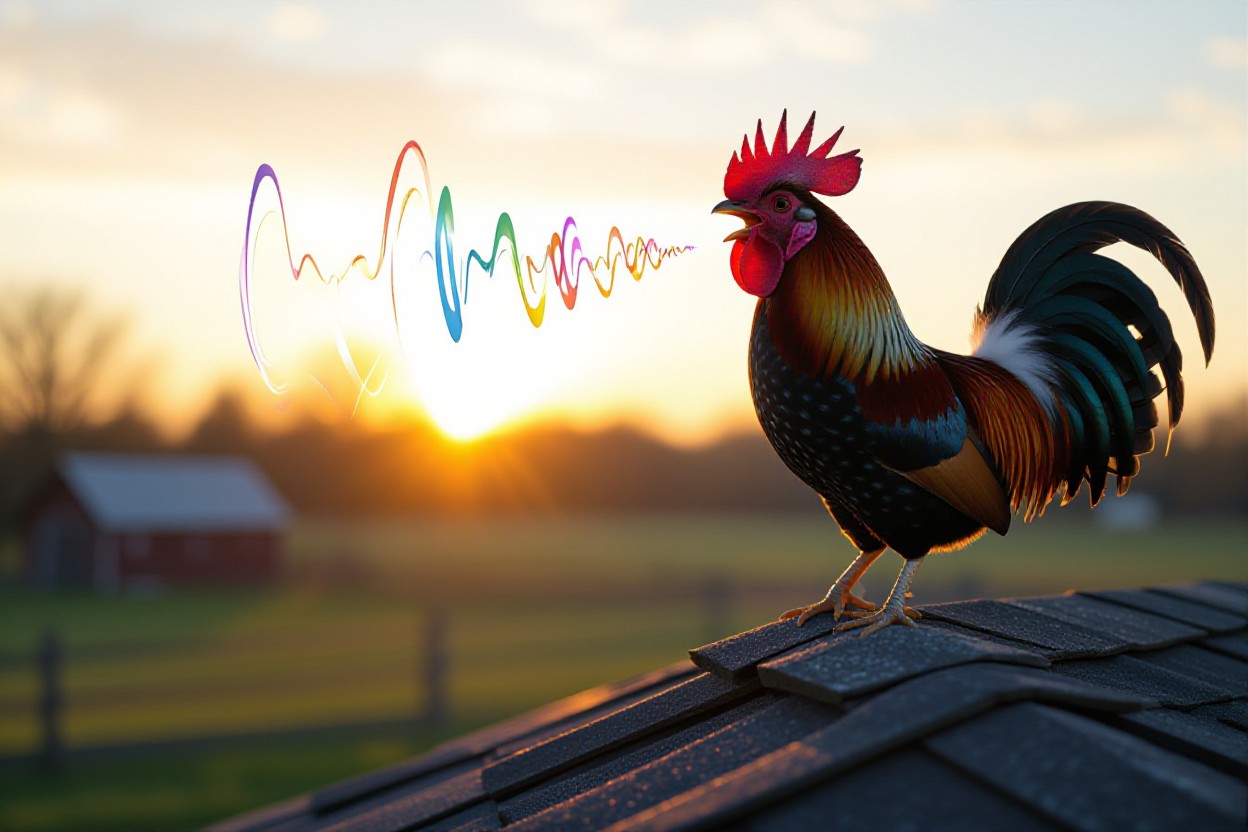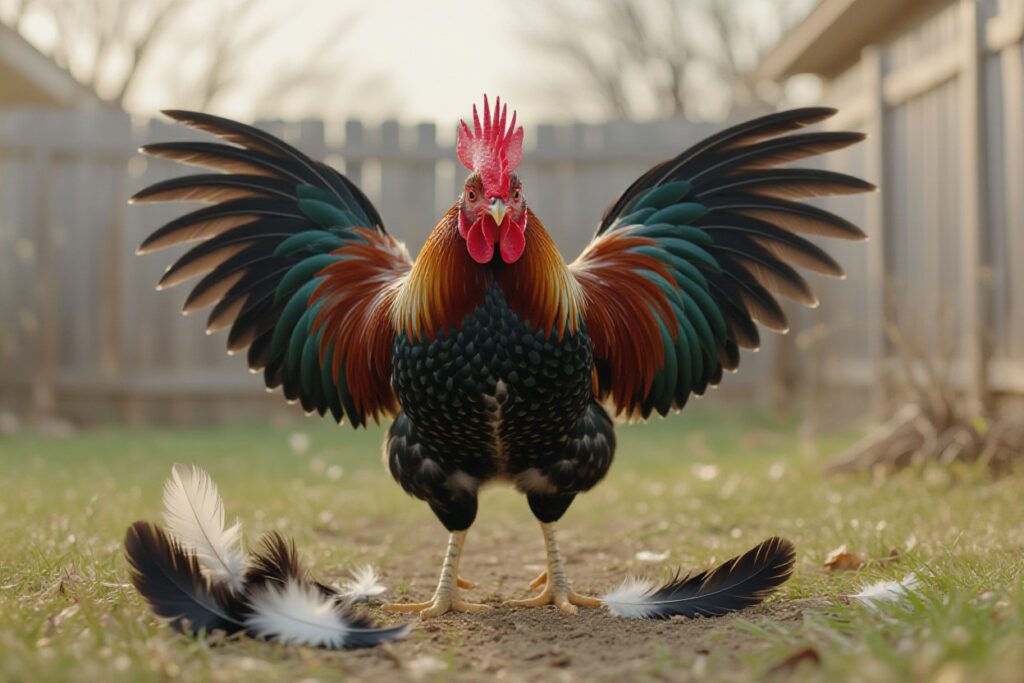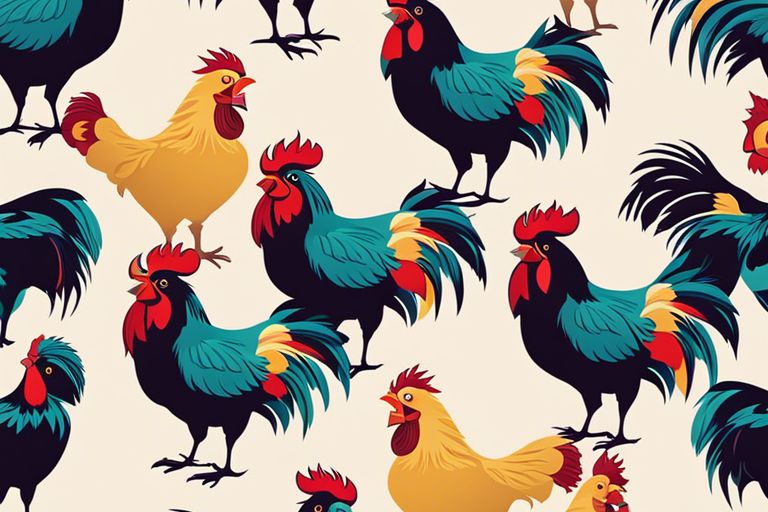Just when you hear a rooster at dawn, you likely wonder “what sound does a rooster make” and how to decode its signals; this guide puts you in control by explaining crowing, alarm calls and distress sounds that warn of danger, plus mating calls and contentment noises that reveal positive behaviors, how roosters communicate with hens, why they crow at different times, breed differences, and practical tips for reducing noise to protect your household.
The Crow Explained
Characteristics of the Crow
You’ll notice a typical crow lasts about 1–5 seconds, often delivered in short bouts of 3–12 crows; intensity can exceed 90 dB at close range and be heard up to 1 kilometer in open areas. Pitch, cadence and repetition vary by breed and age—bantams tend toward higher, quicker crows while heavy breeds give slower, lower calls—so when you ask what sound does a rooster make, listen for duration, rhythm and loudness to decode meaning.
Significance of the Crow
You should treat the crow as a multifunctional signal: it delineates territory, advertises fitness to hens, and warns of danger. Dominant males crow most often at dawn and during breeding peaks, helping synchronize flock activity. Because the call can provoke neighborhood complaints, noise impact matters practically, while biologically the crow signals status and deters rivals.
You’ll also see clear developmental and social patterns: cockerels typically begin sporadic crowing around 4–6 months, dominant roosters initiate the bulk of morning bouts, and overall crowing frequency can rise during breeding season and stressful events, reinforcing hierarchy and mate attraction.
Types of Rooster Calls
You can distinguish common calls by tone, tempo, and context to decode what sound does a rooster make and act accordingly; for example, a clear crow at dawn versus a rapid, high-pitched alarm when a hawk appears. Field observations show roosters give 1–4 distinct call types most often and breed affects volume—Leghorns are louder, Brahmas are deeper. Understanding these differences helps you manage your flock. This breakdown gives you quick, usable cues.
- Morning calls — territorial dawn crows
- Alarm calls — sharp, urgent warnings
- Social calls — clucks and tidbitting to hens
- Mating calls — low purrs and specific cues
- Distress/contentment — squeals or soft coos
| Morning Calls | Long, resonant crows at or before sunrise (0.5–2.5s), used for territory and time cues; often 1–10 crows in early hour. |
| Alarm Calls | Short, sharp notes or rapid series (3–10 notes) signaling aerial or ground predators; triggers hen freeze or scatter response. |
| Social Calls | Soft clucks, purrs, and tidbitting to locate or recruit hens to food and reinforce hierarchy during foraging. |
| Mating Calls | Low-frequency purrs and short calls paired with dance displays; frequency rises in spring and may indicate 5–15 courtship attempts daily. |
| Distress/Contentment | Squeals or wheezy calls for pain or threat versus gentle coos when content; context determines whether you should intervene. |
Morning Calls
You’ll notice a rooster’s dawn crow is long and projected—typically 0.5–2.5 seconds—serving both to assert territory and synchronize the flock; in studies, roosters crow most frequently within the first hour of light, producing up to 10 crows as sunlight increases. If you track timing, you can predict peak noise and plan coop routines. Use this to reduce disturbances when managing neighbors or scheduling free-range time.
Alarm Calls
You’ll hear alarm calls as abrupt, high-pitched bursts or rapid “kek-kek” series—often 3–10 notes—when predators appear; aerial alarms are faster and higher, ground alarms are lower and repeated. A rooster’s sharp alarm usually causes hens to freeze or hide, and you should check the area immediately. Prioritize safety when you hear these urgent signals.
Roosters tailor alarms by predator type: for example, a hawk sighting often elicits a rapid 5–8 note sequence forcing hens under cover, while a fox provokes repeated lower alarms; observationally, flocks exposed to regular predation respond faster and more cohesively, so if your birds alarm frequently, you should reinforce fencing, close coop access, and monitor at dawn and dusk. Respond quickly to reduce losses.
Social Calls
You’ll recognize social calls as soft clucks, purrs, and the classic “tidbitting” sound when a rooster shows food to hens; these calls coordinate feeding and maintain social bonds, often lasting 5–15 seconds during foraging sessions. Pay attention to callers—dominant roosters use more frequent tidbitting to lead hens to treats. These positive signals indicate flock cohesion.
Beyond recruitment, social calls regulate hierarchy: subordinate roosters emit fewer tidbitting calls and more submissive clucks, while dominant birds perform repeated sequences during feeding times, sometimes initiating 10–20 calls in a 30-minute patch; by observing call patterns you can identify bullying, adjust feeding stations, and ensure all hens access food without harassment. Use call monitoring to manage welfare.
Mating Calls
You’ll hear mating calls as a mix of low purrs, soft crows, and brief clucks often paired with a dance and mounting attempts; frequency spikes in spring, and an experienced rooster may attempt 5–15 courtships per day depending on flock size. Watch hen response—acceptance is marked by crouching—so you can assess breeding success. These calls signal reproductive intent.
Mating calls also communicate male fitness: roosters with richer, lower-frequency purrs and more persistent displays tend to secure more matings in mixed flocks; if you’re breeding, record call patterns and mating counts to select for desired traits like calmness and efficient courtship rather than excessive aggression. Monitor to optimize breeding outcomes.
This final snapshot helps you apply call recognition to everyday flock management.

Why Roosters Vocalize
You’ll hear roosters crow for several functional reasons: claiming territory, signaling time, alerting to danger and attracting mates. A typical crow lasts about 1–5 seconds and often comes in bouts of 3–12 crows, so when you ask “what sound does a rooster make” know it’s a multi-purpose signal that encodes status, location and urgency for your flock.
Communication with Flock
When you watch a rooster, you’ll notice distinct calls: soft clucks to gather hens, short alarm yelps to warn of hawks, and repeated low crows to rally the group. In backyard flocks of 8–15 birds, roosters commonly give 2–5 soft contact calls before moving hens to feed, and alarm calls often prompt your hens to freeze or run for cover within seconds—vital for predator avoidance.
Territory Establishment
Roosters use crowing and patterned calls to mark and defend territory; you’ll hear more frequent crows when a new male appears or when boundaries are tested. Frequencies can rise from a handful at dawn to several times an hour during territorial disputes, and that escalation often precedes chasing or fights—so treat increased crowing as a sign of potential aggression.
In practice, your dominant rooster will patrol a radius of roughly 10–20 meters, pausing to crow, fan tail feathers and perform threat displays. You’ll also observe quick ritualized fights—feather pecking, spur checks—after vocal challenges; managing introductions slowly and providing escape space reduces injury risk and lowers persistent territorial crowing.
Breed Differences
You’ll notice that breed shapes both how often and how a rooster calls: Leghorns and Rhode Island Reds tend to crow frequently and persistently, while Orpingtons and Australorps produce fewer, deeper crows. Silkies and many bantams are notably quieter, making them preferable if you want less noise from your flock. Game-type breeds often deliver sharper, more insistent calls, so if you keep Old English Game expect louder, more aggressive vocal behavior.
Vocalization Patterns by Breed
Different breeds show distinct patterns: Leghorns often crow at dawn and sporadically through the day, whereas Malay and Jersey Giant roosters give long, low-frequency crows mainly at territorial triggers. Bantams emit higher-pitched, brief crows that repeat rapidly when alarmed. You can use these tendencies to predict when your birds will call and which birds will dominate morning noise in your yard.
Breed-Specific Calls
Some breeds add unique flavors to standard crowing: Sebrights and Polish types include softer trills and clipped calls during courtship, while gamefowl deliver staccato alarm crows that escalate into repeated sequences. You should pay attention to patterns like the food-related “tidbitting” in certain breeds and the harsh, drawn-out distress calls some large roosters use when separated from hens.
To identify breed-specific calls, listen for pitch, tempo, and context: larger breeds usually produce lower, longer crows and smaller breeds higher, shorter ones, so your ear can separate a Jersey Giant from a bantam at a glance. Recordings you take with your phone help compare duration and repetition; combine that with behavior—mating, alarm, or territorial—to match calls to breeds in your flock and pinpoint which rooster is driving the noise.

Managing Noise
Noise Control Strategies
To reduce what sound does a rooster make, start by orienting the coop away from neighbors and adding 2–4 inch insulation panels plus a double-door entry to cut reflections; these measures can lower loud crowing by up to 10–15 dB. You can also limit early-morning crowing with covered perches, use white-noise machines or vegetation barriers, and select quieter breeds or keep fewer males—aim to get sound at the property line below 55–65 dB where many ordinances lie.
Legal Considerations
Check local noise ordinances, zoning rules, HOA covenants and animal-control regulations because some areas explicitly restrict poultry or roosters; roosters are banned in some cities such as New York City. If a neighbor complains you may face warnings, citations or fines of $50–$500 and possible abatement orders, so document incidents with timestamps and decibel readings from a phone app to support your case.
For deeper compliance, verify municipal code online or call the local planning or animal-control office, noting common provisions: quiet hours (often 10 PM–7 AM), minimum lot-size exemptions (many jurisdictions require 1–2 acres for multiple roosters), and permit requirements. Prepare a noise log, recordings, and coop-modification receipts to expedite appeals or mediation if enforcement action occurs.
FAQs
Common questions answered
Quick answers: If you ask “what sound does a rooster make,” expect three to five main call types — crowing (dawn and territorial), sharp alarm calls that signal predators, tidbitting mating calls, high-pitched distress screams, and soft contentment clucks; you’ll hear Leghorns crow with longer, louder crows while Silkies and Bantams produce quieter calls; roosters may crow repeatedly at sunrise (often 5–20 times) and sporadically during the day; to reduce noise, you can change lighting, use soundproofing, or select quieter breeds.
Conclusion
Now you can identify what sound does a rooster make and interpret its crowing, alarm, mating, distress, and contentment calls using time-of-day patterns and breed cues to decode vocalizations; this lets you improve flock communication, manage noise, and respond appropriately to hen interactions and threats so your observations become practical tools for healthier, calmer birds.











